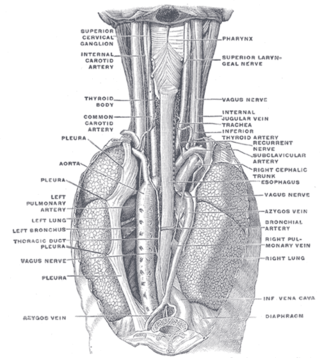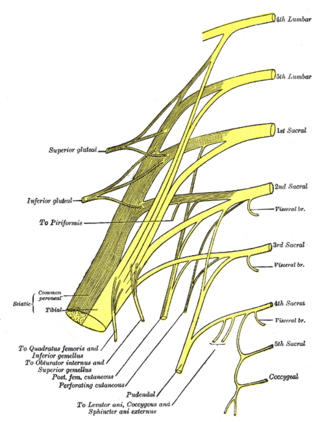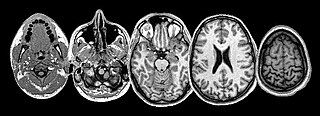Related Research Articles

The leg is the entire lower limb of the human body, including the foot, thigh or sometimes even the hip or buttock region. The major bones of the leg are the femur, tibia, and adjacent fibula. There are 60 bones in each leg.
Articles related to anatomy include:

In human anatomy, the subclavian arteries are paired major arteries of the upper thorax, below the clavicle. They receive blood from the aortic arch. The left subclavian artery supplies blood to the left arm and the right subclavian artery supplies blood to the right arm, with some branches supplying the head and thorax. On the left side of the body, the subclavian comes directly off the aortic arch, while on the right side it arises from the relatively short brachiocephalic artery when it bifurcates into the subclavian and the right common carotid artery.

The azygos vein is a vein running up the right side of the thoracic vertebral column draining itself towards the superior vena cava. It connects the systems of superior vena cava and inferior vena cava and can provide an alternative path for blood to the right atrium when either of the venae cavae is blocked.

The popliteal artery is a deeply placed continuation of the femoral artery opening in the distal portion of the adductor magnus muscle. It courses through the popliteal fossa and ends at the lower border of the popliteus muscle, where it branches into the anterior and posterior tibial arteries.

In human anatomy, the abdominal aorta is the largest artery in the abdominal cavity. As part of the aorta, it is a direct continuation of the descending aorta.

The mediastinum is the central compartment of the thoracic cavity. Surrounded by loose connective tissue, it is a region that contains vital organs and structures within the thorax, namely the heart and its vessels, the esophagus, the trachea, the vagus, phrenic and cardiac nerves, the thoracic duct, the thymus and the lymph nodes of the central chest.
The anterior tibial artery is an artery of the leg. It carries blood to the anterior compartment of the leg and dorsal surface of the foot, from the popliteal artery.

The tibial nerve is a branch of the sciatic nerve. The tibial nerve passes through the popliteal fossa to pass below the arch of soleus.

In anatomy, the left and right common carotid arteries (carotids) are arteries that supply the head and neck with oxygenated blood; they divide in the neck to form the external and internal carotid arteries.

In human anatomy, the sacral plexus is a nerve plexus which provides motor and sensory nerves for the posterior thigh, most of the lower leg and foot, and part of the pelvis. It is part of the lumbosacral plexus and emerges from the lumbar vertebrae and sacral vertebrae (L4-S4). A sacral plexopathy is a disorder affecting the nerves of the sacral plexus, usually caused by trauma, nerve compression, vascular disease, or infection. Symptoms may include pain, loss of motor control, and sensory deficits.

The deep fibular nerve begins at the bifurcation of the common fibular nerve between the fibula and upper part of the fibularis longus, passes infero-medially, deep to the extensor digitorum longus, to the anterior surface of the interosseous membrane, and comes into relation with the anterior tibial artery above the middle of the leg; it then descends with the artery to the front of the ankle-joint, where it divides into a lateral and a medial terminal branch.

The inferior phrenic artery is a bilaterally paired artery of the abdominal cavity which represents the main source of arterial supply to the diaphragm. Each artery usually arises either from the coeliac trunk or the abdominal aorta, however, their origin is highly variable and the different sites of origin are different for the left artery and right artery. The superior suprarenal artery is a branch of the inferior phrenic artery.

The inferior thyroid artery is an artery in the neck. It arises from the thyrocervical trunk and passes upward, in front of the vertebral artery and longus colli muscle. It then turns medially behind the carotid sheath and its contents, and also behind the sympathetic trunk, the middle cervical ganglion resting upon the vessel.
In anatomy, arterial tree is used to refer to all arteries and/or the branching pattern of the arteries. This article regards the human arterial tree. Starting from the aorta:

This article describes the anatomy of the head and neck of the human body, including the brain, bones, muscles, blood vessels, nerves, glands, nose, mouth, teeth, tongue, and throat.

The intercostal arteries are a group of arteries passing within an intercostal space. There are 9 anterior and 11 posterior intercostal arteries on each side of the body. The anterior intercostal arteries are branches of the internal thoracic artery and its terminal branch – the musculophrenic artery. The posterior intercostal arteries are branches of the supreme intercostal artery and thoracic aorta.

A malleolus is the bony prominence on each side of the human ankle.

The following outline is provided as an overview of and topical guide to human anatomy:
References
- ↑ "Skeletal Anatomy: Vertebrae and Thoracic Cage" . Retrieved 28 January 2015.
- 1 2 3 4 5 6 7 8 "Anatomy" (PDF). medicalmnemonics.com. Retrieved 14 February 2015.
- ↑ "Inferior vena cava: tributaries". LifeHugger. 27 September 2009.
- 1 2 3 4 "Mediastinum".
- ↑ "Posterior mediastinum: Contents". LifeHugger. 27 September 2009.
- ↑ "Foramen magnum".
- ↑ "Tarsal Tunnel Syndrome & Nerve Entrapments". Archived from the original on November 4, 2006. Retrieved 2014-02-18.
{{cite web}}: CS1 maint: bot: original URL status unknown (link) - ↑ "Find Doctors Near You: Top Physician Directory". doctor.medscape.com. Archived from the original on December 1, 2008.
- ↑ MedicalMnemonics.com: 1182 7
- ↑ "Medical mnemonics". LifeHugger. Retrieved 2009-12-19.
- ↑ Niknejad, Mohammad Taghi. "Popliteal fossa anatomy (mnemonic) | Radiology Reference Article | Radiopaedia.org". radiopaedia.org. Retrieved 2017-07-18.
- ↑ "Diaphragm".
- ↑ Wilson, Herbert H. Srebnik; illustrations by Genevieve M. (2002). Concepts in anatomy. Boston: Kluwer Academic Publishers. p. 70. ISBN 0792375394.
{{cite book}}: CS1 maint: multiple names: authors list (link) - ↑ Textbook of Basic Nursing by Caroline Bunker Rosdahl and Mary T. Kowalski (Lippincott Williams & Wilkins, 2007) p194; Medical Terminology for Dummies by Beverley Henderson and Jennifer Dorsey (For Dummies, 2008) p327
- ↑ Caroline Bunker Rosdahl and Mary T. Kowalski, Textbook of Basic Nursing (Lippincott Williams & Wilkins, 2007) p194
- ↑ Dennis Long (2006). Vive Les Verbes Français!: 6,000 Verbs to Add Savoir-Flair to Your French. McGraw-Hill Professional. p. 8. ISBN 978-0-07-147875-5.
- ↑ Kevin C. Wang; Rita A. Mukhtar; Rodrigo E Saenz (2005). Hardcore Neuroscience. Lippincott Williams & Wilkins. p. 23. ISBN 978-1-4051-0471-5.
- ↑ Saladin, Kenneth S. (2008). Human anatomy (2nd ed.). McGraw-Hill Higher Education. ISBN 978-0-07-110209-4.
- ↑ MedicalMnemonics.com: 38
- ↑ Ziser. "The Endocrine System (Major Endocrine Glands)" (PDF). p. 1. Retrieved 21 April 2015.
- ↑ "Four layers of the Gastointestinal Tract". University of Leeds. Retrieved 12 May 2015.
- ↑ Mega List of Mnemonics for Nurses & Nursing Students. Examville Study Guides. 2010.
- 1 2 Standring, Susan (21 October 2020). Gray's anatomy : the anatomical basis of clinical practice. ISBN 978-0-7020-7705-0. OCLC 1202943188.
- ↑ Le, Tao (22 December 2014). First Aid for the USMLE Step 1 2015. ISBN 978-0-07-184007-1. OCLC 1059034925.
19. ScienceMnemonic - An Easy Way To Memorize Your Science Knowledge Using Mnemonics, Pictures, Visuals, Acronyms, Usage, Examples, Or Word Games.